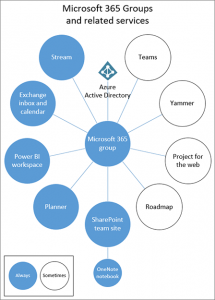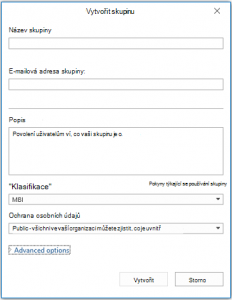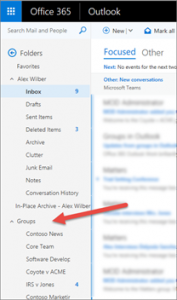
Behind the scenes of Microsoft 365 Groups: how to properly set up a new team in Teams or Outlook?

Anyone can form a team in MS Teams, and if the organization allows it, it’s no problem. But do you know what all is created in the background and what your newly created team is connected to? After reading this article, you will agree that your new knowledge will pay off.
Vojta Blejchař
First, let’s see what the four types of groups that can be created in Azure Active Directory are used for:
- Distribution list – used to send email notifications
- Security – we use when granting SharePoint access
- Mail-enabled security – similar group including sending notifications
- Microsoft 365 – used for collaboration within the team
Distribution list
Distribution groups are best suited for situations where you need todistribute information to a set group of people, such as People in Building A or Everyone in the company.
You can add a distribution group to your team in Microsoft Teams or in SharePoint. It can also be upgraded to the so-called. M365 group (see below).
Security
Security groups are used to grant access in Microsoft 365, such as SharePoint. They make it easier to manage because you just manage the group and don’t have to add users to each document or folder individually.
Security groups can contain users or devices and can also be added to a team.
Mail-enabled security
Mail-enabled security groups work just like regular security groups, except that they cannot be dynamically managed through Azure AD and cannot contain devices.
Among other things, they include the ability to send mail to all members of the group.
Microsoft 365
Now we finally get to the heart of the matter. The team in MS Teams is based on the so-called Microsoft 365 group. You can create it in a variety of ways, such as from Outlook, SharePoint Online, Planner, or the aforementioned Teams. Other applications are associated with this group based on where you create it from or what you associate with it.
When you create a Microsoft 365 group, you must decide whether it is a private or public group. It depends on whether you want users from your organisation to be able to join this group.
This is best understood from the following figure.

Source: Microsoft 365 Groups and Microsoft Teams – Microsoft Teams | Microsoft Docs
If you create a Microsoft 365 group from one of the blue apps, it will automatically be created in the other “blue apps” as well. However, areas marked in white in the diagram will not be assigned to this group.
In addition, if you create a group from an application marked in white, the group will also be created in all applications marked in blue. Other “white apps” can be added later.
Two examples of creating an M365 group
1. If you are setting up a group from Outlook, do the following:

The group you created will appear in the left menu among all the M365 groups you are involved in. In each group, you can see all of its email communications. Just send an email to the selected group and it will be sent to all members in that mailbox.

When you create a group from Outlook, the following will be created:
- Shared mailbox and shared calendar
- Planner
- SharePoint web
- OneNote
- Stream
To manage and organize your M365 group, you don’t have to use just MS Outlook, but any of the applications mentioned above.
2. When you create a group from MS Teams, it will create:
- Teams with main channel general
- Shared mailbox and shared calendar
- Planner
- SharePoint web
- OneNote
- Stream
So the same thing as in Example 1 is created, except that a team with a communication channel is created.
So first, decide which apps you’ll use and choose where to create the group from.
Different Microsoft 365 platforms
Shared mailbox and shared calendar
This mailbox is very useful for group communication as it stays closed in the group and separated from other mail. Just send one email to a specific group and it is sent to all its members. The same applies, of course, when scheduling appointments on the calendar.
Planner
Working and planning in a group is the best way to effectively plan time, people capacity and allocate tasks
Stream
Here you will find a shared video portal for the whole group.
Power BI
It is used to display various graphical visualizations with overviews. There has been a recent change here. You create an M365 group only in the classic work environment, in the new modern environment the link between the PowerBI space and the Group is not established. So the “blue colour” doesn’t quite apply here.
Yammer
You can also connect individual M365 groups to this enterprise social network.
Project and Roadmap
When saving a project, you decide whether to save it to an existing group or create a new group.
SharePoint web
Once the group is created, a customized SharePoint site is created to serve as the main space for documents and collaboration with the team. If you delete the original group, this particular site will also stop working. Specific to the SharePoint site is the ease of group management from the site home page.
OneNote
A shared notepad that all users in the group can access. In OneNote, you can keep notes from meetings, product information or even process instructions. For example, you can find it on the SharePoint site of a particular group in the left menu.
Teams
A description of this platform is not the purpose of this article, so I will skip it. I will only mention the modifications to the individual groups. For example, if you’re using a Microsoft 365 group that Teams isn’t connected to and you want to change that, no problem. Users with a role with higher permissions are able to join the M365 group.
SharePoint permission structure
If there is already an M365 group, there is also a dedicated SharePoint site where three main SharePoint groups have been created: Members, Owners and Visitors. You can assign a user or a permission group (security group or M365) to them.
Just for the record, by default you will find the group in M365 SharePoint groups under the name you created it under.
There is permission inheritance throughout the SharePoint site, which you can terminate and set to your liking in many places. For example, to end inheritance on a specific folder, add a new permission, or change the permission level.
Groups can of course be shared across the M365 world. This means that you can safely share SharePoint environments to multiple groups that already exist, without having to assign users individually. This also applies to the nesting of these groups.
To sum it all up, there are many groups in the Microsoft world, and each of them has its own use. You might remember this article as you build your new team and think about what you can use.
This is a machine translation. Please excuse any possible errors.


